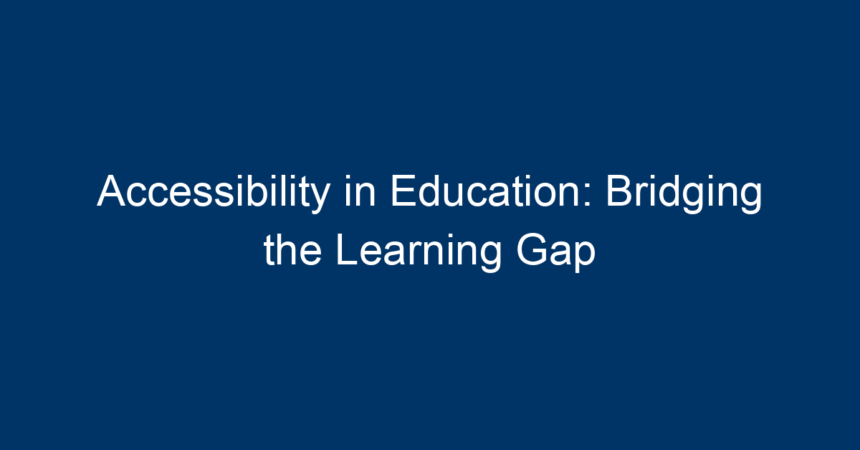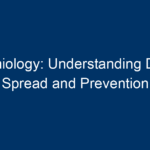Introduction
In an ever-evolving digital landscape, ensuring accessibility in education is crucial for fostering an inclusive learning environment. Education should be a right, not a privilege, but glaring disparities still exist. The gap between those who can readily engage with educational resources and those who face barriers can severely impact broader social equity. This article will explore the importance of accessibility in education, delve into its challenges, and present actionable strategies to bridge the learning gap for all students.
Understanding Accessibility in Education
What is Accessibility?
Accessibility in education refers to the design and implementation of educational resources, programs, and environments that accommodate learners of all abilities. This encompasses students with disabilities, learning differences, and even individuals from diverse cultural backgrounds. Ensuring access means providing equitable opportunities for all students to thrive academically.
The Importance of Accessibility
The significance of accessibility in education extends beyond legal obligations. While laws like the Americans with Disabilities Act (ADA) play a role in ensuring equal opportunity, the moral imperative is even more compelling. Here’s why accessibility matters:
- Promotes Inclusivity: Creating an inclusive educational environment fosters community and social cohesion.
- Enhances Learning Outcomes: When students can access the resources they need, they are more likely to succeed academically.
- Reduces Dropout Rates: By making learning accessible, institutions can decrease the number of students who leave school due to insurmountable barriers.
Challenges of Accessibility in Education
Despite the legally mandated frameworks, numerous challenges persist in realizing true accessibility.
Physical Barriers
Many schools and universities lack the physical infrastructure necessary to accommodate students with mobility challenges. Inadequate ramps, inaccessible restrooms, and poorly designed classrooms can hinder student participation.
Digital Barriers
As education increasingly shifts online, the digital divide becomes more pronounced. Websites and online platforms often lack user-friendly designs for visually impaired and hearing-impaired students. Moreover, the lack of alternative formats for materials (e.g., audio versions or sign language interpretation) exacerbates this issue.
Curriculum Limitations
Traditional curricula often do not consider diverse learning needs. For example, standardized testing may not fairly assess the abilities of all students due to varied learning styles or cognitive challenges.
Awareness and Training
Educators may lack the training necessary to identify and assist students with specific accessibility needs. Moreover, misconceptions about disabilities can lead to unintentional discrimination and exclusion.
Strategies for Improving Accessibility in Education
1. Assessing Needs and Gathering Feedback
To create effective accessibility measures, educational institutions should conduct thorough assessments to identify barriers. Engaging students, parents, and educators in discussions can yield valuable insights into the specific needs of the population.
2. Implementing Universal Design for Learning (UDL)
Universal Design for Learning is an educational framework that guides the development of flexible learning environments to accommodate individual learning differences. Here are the main principles:
- Multiple Means of Engagement: Offer varied options for students to engage with the material, stimulating interest and motivation.
- Multiple Means of Representation: Present information in diverse formats, such as text, audio, video, and hands-on activities.
- Multiple Means of Action and Expression: Encourage students to demonstrate their understanding in various ways, such as written assignments, art projects, or oral presentations.
3. Enhancing Digital Accessibility
With the rise of online education, ensuring digital accessibility is vital. Here are a few strategies:
- Adopt Accessible Technologies: Utilize software and tools designed with accessibility in mind. This includes screen readers, closed captioning, and captioned videos.
- Follow Web Content Accessibility Guidelines (WCAG): Ensure that websites and online platforms comply with these established guidelines to enhance usability for all users.
4. Providing Professional Development for Educators
Training educators is crucial in establishing an accessible learning environment. Institutions should provide ongoing professional development focused on:
- Recognizing and addressing various learning needs.
- Developing inclusive teaching strategies.
- Familiarizing educators with assistive technologies.
5. Creating Support Networks
Establishing support networks, such as peer mentorship programs and tutoring services, can provide additional assistance to students facing challenges. These networks can help reduce feelings of isolation and foster a sense of belonging.
Real-World Examples of Effective Accessibility Practices
Example 1: The University of Illinois
The University of Illinois has implemented a comprehensive accessibility initiative that includes accessible course materials, enhanced online platforms, and dedicated resources for students with disabilities. The university collaborated with students to create an inclusive learning environment that caters to diverse needs.
Example 2: Khan Academy
Khan Academy, an online educational platform, has prioritized accessibility by offering captioned videos, adjustable playback speeds, and resources for varied learning styles. Their commitment has made high-quality education accessible to learners around the globe, regardless of their abilities.
The Future of Accessibility in Education
The Potential of Emerging Technologies
As technology evolves, new opportunities arise to improve accessibility in education. Artificial intelligence, machine learning, and virtual reality can provide transformative tools for personalized learning experiences, accommodating a spectrum of abilities.
Policy Initiatives
Advocating for stronger policies at state and federal levels can help drive significant changes in educational accessibility. Establishing clear standards and funding for accessibility initiatives can create momentum toward a more inclusive environment.
Conclusion
Accessibility in education is not merely an afterthought but a vital component of an equitable society. Bridging the learning gap requires a multifaceted approach—from assessing needs to implementing universal design principles and ensuring ongoing professional development. As we drive towards a more inclusive educational landscape, every step taken to improve accessibility counts.
Actionable Insights
- Get Involved: Advocate for accessibility initiatives within your institution.
- Empower Educators: Encourage training programs focused on diverse learning needs.
- Leverage Technology: Explore available tools that improve accessibility in both physical and digital classrooms.
- Encourage Feedback: Regularly solicit input from students and families to identify ongoing challenges.
By prioritizing accessibility in education, we can pave the way for a future where every learner has the opportunity to succeed, thus enriching our society as a whole.




